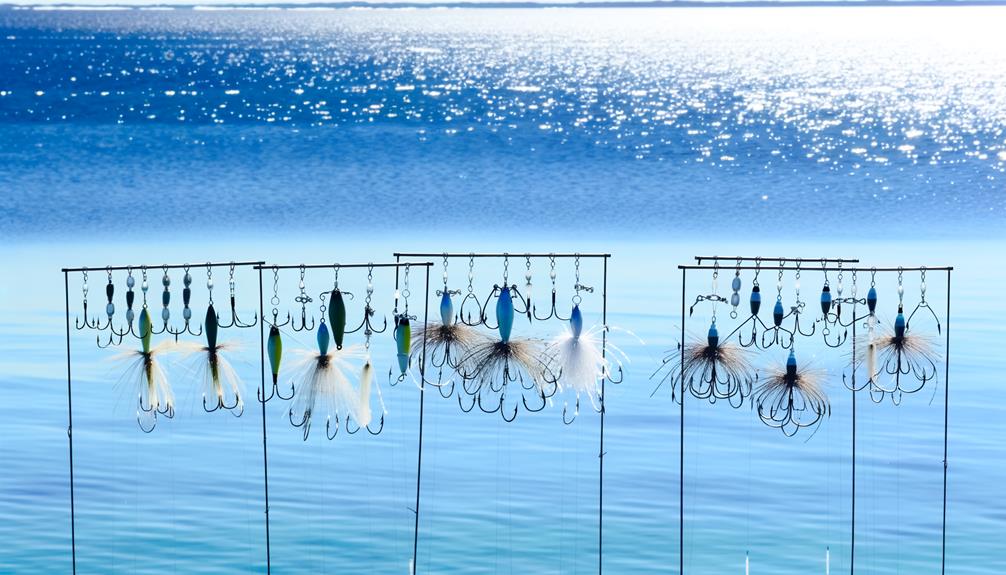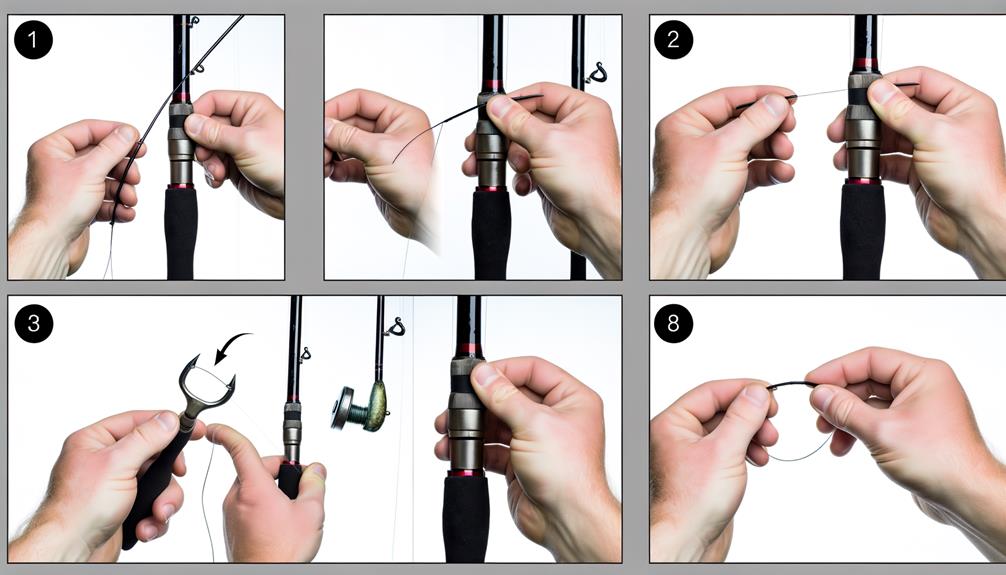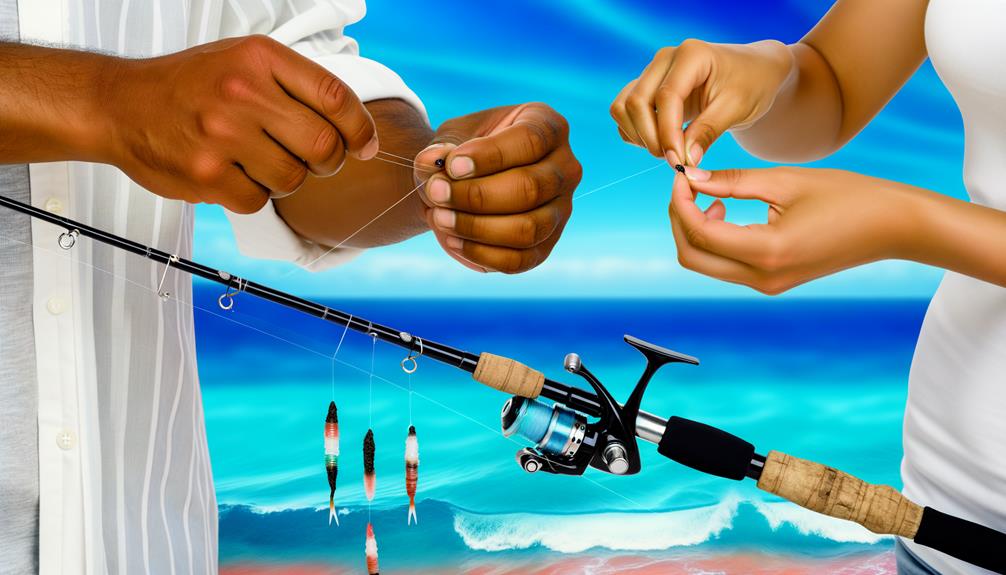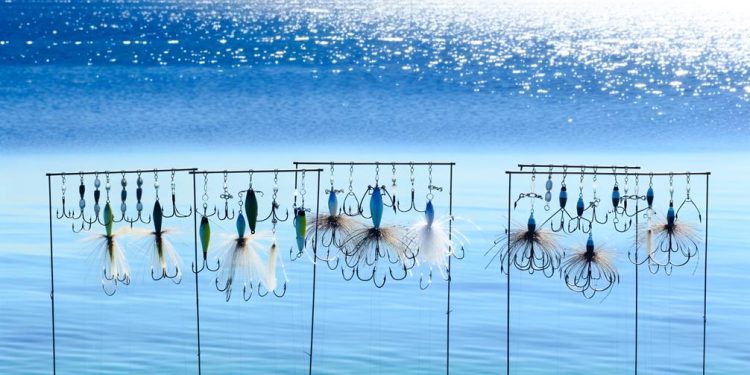How to Set up Saltwater Fishing Line
The art of setting up a saltwater fishing line involves a series of meticulously executed steps, each vital to the success of your fishing expedition. The choice of components, such as the appropriate connectors or knots, hooks or lures, and the selection of suitable weights, all play a pivotal role in this process.
In addition, the type of fishing line, whether mono, fluorocarbon or braided, can make a significant difference. This discourse seeks to explore these elements in depth, providing valuable insights that will enhance your saltwater fishing experience.
Key Takeaways
- Understand the basics of saltwater fishing including techniques, gear selection, rig types, and rigging methods.
- Prepare your fishing pole using a Carolina Rig, which includes components like an offset hook, bullet weight, bead, and swivel.
- Use a leader line for strength and abrasion resistance, tying the hook, lure, or jig to it for successful casting.
- Tailor your fishing line setup to the specific conditions, strategies, and target species for saltwater fishing.
Understanding Saltwater Fishing Basics
In the realm of angling, comprehending the fundamentals of saltwater fishing–a pastime embraced by a staggering 25 million American enthusiasts each year–is key to mastering an array of techniques, from fly-fishing for flounder to the thrilling pursuit of tuna in the deep sea. This form of fishing presents unique challenges, requiring in-depth understanding and application of specific gear and techniques such as the leader line and the Carolina Rig.
The leader line, typically a stronger and more durable line, is indispensable in saltwater fishing. It provides a buffer against the sharp teeth of saltwater species and the abrasive nature of the underwater environment. Moreover, it offers a low-visibility connection between the mainline and the bait, crucial in not spooking wary game fish.
Equally essential is mastering the use of a Carolina Rig, a popular setup for bottom fishing that maximizes bait presentation. The design of this rig allows the bait to move naturally with the current, enticing bites from species like flounder or bass. When correctly utilized, these fundamental tools and techniques pave the way for a rewarding and successful saltwater angling experience. By understanding these basics, one joins the ranks of the millions of Americans who relish this adventurous pastime.
Selecting the Right Fishing Gear
Choosing the appropriate fishing gear plays a pivotal role in saltwater angling, with key considerations including the target species, fishing conditions, and the durability and size of your fishing line. A well-chosen fishing rod, combined with a suitable leader, can significantly enhance your overall fishing experience.
Your fishing tackle should be selected with care, considering the type and size of the fish you intend to catch. A durable, high-quality fishing line resistant to abrasion is critical. The size of the hook should correspond to the bait used, ensuring a successful catch.
Essential saltwater fishing accessories should not be overlooked. Pliers, line cutters, and a well-organized tackle box are indispensable. To improve visibility underwater and increase your chances of a successful catch, consider investing in polarized sunglasses.
Below is a handy table summarizing the essential gear for saltwater fishing:
| Fishing gear | Description |
|---|---|
| Fishing rod and reel | Consider target species and fishing conditions |
| Fishing line | Durable, abrasion-resistant, suitable for target fish size |
| Hooks | Size and style should match bait and target fish size |
| Accessories | Includes pliers, line cutters, and tackle box |
| Polarized sunglasses | Reduce glare, improve underwater visibility |
Types of Saltwater Fishing Rigs

Understanding the different types of saltwater fishing rigs is fundamental to successful angling. These can vary from basic setups, such as Surf and Bottom Fishing rigs, to more complex arrangements like the Carolina Rig used with lures.
The selection of the correct rig, coupled with knowledge of effective rigging techniques, significantly influences your catch rate, making it vital to master these concepts.
Basic Saltwater Fishing Rigs
Delving into the various types of saltwater fishing rigs, one finds a diverse array comprising of Surf Fishing rigs, Lure Fishing setups, Bottom Fishing rigs, and Pier Fishing rigs, each meticulously designed for specific locations, conditions, and species.
For instance, a Surf Fishing rig typically includes one or two hooks, a weight, and a connector, ideal for casting in coastal waters. Lure Fishing often involves a versatile Carolina Rig, enabling effective lure presentation in saltwater environments.
Bottom Fishing rigs, featuring two hooks and a sinker, target species dwelling near the seabed. Meanwhile, Pier Fishing rigs, like the Carolina and Float Rigs, are designed to catch fish from piers or docks, affirming the importance of rig selection in successful saltwater fishing.
Choosing the Right Rig
In the realm of saltwater fishing, the careful selection of an appropriate rig—be it a Surf, Bottom, or Pier Fishing setup—is a pivotal factor, heavily influencing the likelihood of a successful catch based on the specific conditions, location, and targeted species. Different types of saltwater rigs offer versatility and effectiveness, all of which can be enhanced with a sturdy fluorocarbon leader and circle hook.
| Rig Type | Best for |
|---|---|
| Surf Fishing Rig | Casting inshore or near the shore |
| Bottom Fishing Rig | Targeting bottom-dwellers like grouper and snapper |
| Pier Fishing Rig (Carolina or Float Rig) | Fishing off piers and docks |
Each rig offers unique advantages, making the right choice a critical part of your fishing strategy.
Rigging Techniques and Tips
Mastering various rigging techniques is essential for maximizing the effectiveness of saltwater fishing rigs such as surf fishing rigs, bottom fishing rigs, and pier fishing rigs. A well-rigged line can significantly increase your hook-up rate, ensuring a successful fishing trip.
Understanding these techniques will assist you in tailoring your setup to specific scenarios:
- The Carolina Rig, versatile and effective, utilizes weights and swivels for optimal bait presentation.
- The Three-Way Swivel rig, ideal for large live baits, offers increased efficacy in bottom fishing scenarios.
- The In-line Snapper Rig allows the bait to move naturally away from the weight, perfect for catching snappers and groupers.
Preparing Your Saltwater Fishing Pole

To prepare your saltwater fishing pole effectively, a versatile setup known as the Carolina Rig is often recommended due to its proven efficacy in saltwater conditions. This rig involves specific components that include an offset hook, bullet weight, bead, and swivel, all of which are necessary to achieve a successful catch in saltwater environments.
Slide the bullet weight and bead onto the line. This combination creates resonance, attracting fish to your line. After this, attach a leader line to the swivel; this line can range from 15 to 24 inches depending on the fishing conditions you expect. The leader line is a critical part of the setup, offering the necessary strength and abrasion resistance when dealing with saltwater species.
The final step is to tie your chosen hook, lure, or jig to the leader line. Bait it appropriately for the type of fish you’re targeting, and you’re ready to cast your line.
Here’s a quick overview:
| Step | Action |
|---|---|
| 1 | Slide bullet weight and bead onto line |
| 2 | Attach leader line to swivel |
| 3 | Determine leader line length (15-24 inches) |
| 4 | Tie hook, lure, or jig to leader line |
| 5 | Bait and cast line |
With these steps, you’re prepared for a successful saltwater fishing adventure.
Techniques for Bottom Fishing
Navigating the art of bottom fishing requires a keen understanding of specific techniques and rigs designed to target fish residing near the seafloor, such as amberjack and grouper. Your fishing line is the direct link between you and your catch, so it’s essential to set it up appropriately for bottom fishing.
Implementing the right rig according to the targeted species and conditions significantly enhances your chances of success. For instance, pressured reef fishes like snappers respond well to long leaders with a three-way swivel. On the other hand, the In-Line Snapper Rig is ideal when you want to keep the weight away from the hook, allowing natural bait movement.
Here are a few key considerations:
- Use Three-Way Swivel Rig or Knocker Rig for specific fish species and conditions.
- Opt for the In-Line Snapper Rig to allow your bait to move naturally, attracting fish effectively.
- Employ Deep Drop & Chicken Rigs for deep-water bottom fishing, ensuring visibility with glow sticks.
When you reach the end of the line, it’s crucial to remember that the type of rig used can greatly influence your bottom fishing success.
Best Practices for Saltwater Fishing
In the realm of saltwater fishing, employing certain best practices can greatly enhance your success and the overall experience. One of the most effective ways to ensure a strong line is to use durable and corrosion-resistant materials like braided or fluorocarbon fishing lines. They are capable of withstanding the rigors of the saltwater environment.
Equally important is the careful selection of hooks. The size and style should be determined by the target species and fishing conditions. An improved clinch knot can be highly useful in securing the hook, providing a reliable connection that can hold up under pressure.
Incorporating weights or sinkers into your setup is another best practice. These aids help your bait or lure reach the desired depth, increasing your chances of attracting the species you are targeting. Connecting your main line and leader with a barrel swivel ensures a secure and flexible connection, which is essential for managing the movements of a fighting fish.
Lastly, regular inspection and maintenance of your line are vital. This preventative measure helps to avoid any unexpected failures due to wear and tear from harsh saltwater conditions. With these best practices, you can fully immerse yourself in the rewarding world of saltwater fishing.
Responding to a Saltwater Fish Bite
Responding to a saltwater fish bite requires a keen understanding of the signs, strategic reeling techniques, and safe handling of the catch.
It’s crucial to maintain constant tension on the line and use steady, consistent movements to control the fish. Equally important is keeping the rod tip elevated, practicing patience, and staying focused throughout the process to successfully land the saltwater fish.
Recognizing Fish Bite Signs
Recognizing the signs of a fish bite while saltwater fishing involves keen observation and alertness, particularly in terms of rod tip movement, line tension changes, and unusual resistance on the line. The end of the leader is often the first to experience these changes, therefore, it’s crucial to keep a watchful eye. A common denominator among successful anglers is their ability to discern these subtle signs.
Here are three key indicators to recognize fish bite signs:
- A sudden slack or change in line tension often indicates fish activity
- Subtle taps or pulls on the line could signal a fish investigating the bait
- The rod bending or a sudden dip suggests a fish has taken the bait and is swimming away
Stay alert to these signs to enhance your saltwater fishing experience.
Proper Reeling Techniques
Once a fish bite is detected, employing the correct reeling techniques becomes essential to maintain control and ensure a successful catch in saltwater fishing.
Unlike freshwater fishing, saltwater anglers often face larger, more aggressive species and must adjust their responses accordingly.
Upon sensing a bite, immediately orient your rod downward to accurately perceive the fish’s movements. Swiftly raise the rod to effectively set the hook, maintaining a constant tension to prevent the fish from escaping.
Reel the fish at least 12 feet off the bottom, avoiding underwater structures. Resist allowing the fish to take excess line, as this could lead to loss of control.
Cognizance of the fish’s behavior allows for necessary adjustments, enhancing your prospects of a successful catch.
Handling Caught Fish Safely
In the aftermath of a successful saltwater fish bite, employing mindful and ethical fish handling techniques becomes crucial to ensure the well-being of the fish and promote sustainable local fishing practices. These practices not only protect the fish, but also maintain the balance of our marine ecosystems.
- Always use wet gloves or a wet towel to handle the fish. This precaution protects the fish’s slime coat, vital for its health.
- Avoid touching the gills or eyes, as these are sensitive areas and can cause undue stress or injury to the fish.
- Utilize a dehooking tool or pliers to safely remove the hook, minimizing harm to the fish.
This compassionate approach to handling caught fish, especially when using live bait, fosters a sense of belonging amongst our fishing community, creating a culture of respect for our shared natural resources.
Tips for Successful Saltwater Fishing
Successful saltwater fishing requires the use of high-quality, corrosion-resistant gear specifically designed to withstand the harsh salt content. This is especially true in shallow water where the salt concentration can be particularly high. The kind of rig you use can also greatly influence your success. Tailoring your rigging techniques based on the target species and current fishing conditions can drastically improve your catch rate.
Maintaining your gear is equally important. Rinse all metal gear with freshwater after each use to prevent corrosion and apply silicone-based lubricants to keep them in top shape. The longevity and performance of your gear can directly impact your success out on the water.
Understanding the nuances of different saltwater environments is also crucial. Adapting your rig according to these nuances can enhance your fishing results. A properly rigged fishing line with the suitable knots, hooks, and sinkers is essential for a successful saltwater fishing experience.
Advanced Saltwater Fishing Techniques

As we progress into the realm of advanced saltwater fishing techniques, two vital aspects come to the fore: mastering bait selection and perfecting casting techniques.
The choice of bait is paramount and requires an astute understanding of the target species’ feeding habits, as well as the prevailing environmental conditions.
Similarly, honing your casting skills can significantly enhance your fishing efficiency, particularly in terms of distance and accuracy.
Mastering Bait Selection
Examining the feeding habits and preferences of your target species is a crucial step in selecting the most effective bait for advanced saltwater fishing. Recognizing the distinct correlation between the feeding patterns of different saltwater species and their preferred diet can dramatically enhance your bait selection process and, subsequently, your catch rate.
Consider these key points during your bait selection:
- Matching the bait to the fishing conditions, including water clarity, temperature, and current.
- Adapting your bait choice, whether live bait, cut bait, artificial lures, or flies, to attract different types of fish.
- Utilizing scent, color, and movement to make your bait more appealing.
Perfecting Casting Techniques
In the realm of advanced saltwater fishing, perfecting casting techniques becomes a pivotal skill, enabling the angler to accurately reach specific targets and structures, thereby increasing the likelihood of a successful catch.
Understanding wind direction and velocity can significantly enhance casting accuracy, especially in challenging saltwater environments. Overhead casting, sidearm, and roll casting are techniques that, when mastered, add versatility to your angling, regardless if you’re fly fishing or using traditional methods.
Utilizing baitcasting or spinning reels further allows you to tailor your casting techniques to the specific conditions of the fishing environment. Remember, practice makes perfect.
As you refine your casting techniques, you’ll find that precision and versatility are key to your saltwater fishing success.
Maintaining Your Saltwater Fishing Gear
Proper maintenance of your saltwater fishing gear is critical to its performance and longevity, requiring a regimen of regular washing, lubrication, inspection, and part replacements. Regularly inspect your gear, paying special attention to your short leader, which is susceptible to damage from both the catch and the corrosive saltwater environment.
To ensure the best performance of your equipment, follow these key steps:
- Rinse all gear with freshwater after each use. This simple act can prevent the build-up of salt which can cause rust and corrosion.
- Apply a silicone-based lubricant such as WD-40. These lubricants displace moisture and extend the lifespan of your gear.
- Store your gear in a dry place. This prevents moisture damage and maintains the functionality of your equipment.
Replacing worn-out components such as hooks, swivels, and lines is also important to prevent equipment failure. By adhering to these maintenance steps, you not only extend the life of your saltwater fishing gear but also improve your fishing experience, ensuring you are part of the proud community of saltwater anglers who value their equipment as much as the catch.
Frequently Asked Questions
How Do You Rig a Salt Water Fishing Line?
To rig a saltwater fishing line, select a strong leader line for optimal line strength. Choose suitable bait according to target species. Attach the bait to your hook or lure, ensuring secure knots for reliability.
What Is the Best Rig for Saltwater Fishing?
The best rig for saltwater fishing largely depends on the target species and fishing conditions. Rig maintenance and choosing the right bait are crucial. Consider Carolina, Float, or Three-Way Swivel rigs for optimal results.
How Do You Put Weight on a Saltwater Fishing Line?
Weight placement strategies for a saltwater fishing line involve selecting appropriate weights based on water depth and target species, and securing them above the hook or lure for optimized balance and effective presentation.
What Is the Best Setup for Ocean Shore Fishing?
The optimal setup for ocean shore fishing integrates a versatile rig, appropriate weight, and strategic bait selection. Spot identification, considering factors like species habitat and water depth, is crucial for a fruitful fishing experience.
Conclusion
In conclusion, saltwater fishing requires a thoughtful approach to gear selection and setup, coupled with knowledge of varying techniques.
A 2019 survey by the National Oceanic and Atmospheric Administration revealed that 8.9 million Americans participated in saltwater fishing, underscoring its popularity.
By understanding the basics, choosing the right gear, and maintaining it well, any aspiring angler can join this community and enjoy the rewarding experience of saltwater fishing.





Comments 1